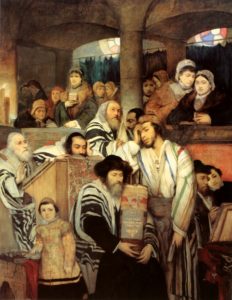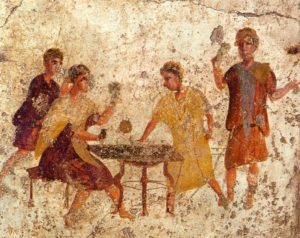Ancient Roman Family Life: The basic institution of the ancient Roman society was family, a Latin word meaning family. The ancient Roman household comprised of the Head of the family (usually the father or the oldest male) called paterfamilias, his wife, and children.

The upper classes had slaves and servants also as part of the family. The head of the family had great power over the other members of the household (patria potestas, meaning “father’s power”).
A day in the life of a roman child
He could compel marriage and divorce for money, send his children for slavery, claim undue ownership of property of his dependents, punish and even kill a member of the family( though this right completely ceased to be exercised after the 1st century BC).

During the early period of ancient Roman history, a daughter when married fell under the control of the head of her husband’s household. A woman had no rights and authority. Her only duty was to procreate and take care of the children.
Ancient Rome family Roles
The Role of the ancient Roman family was to inculcate morality and social values and to transmit them across generations. The elders educated the young and taught them the lessons of the worldly Roman Family Life.

The structure of the family in ancient Roman times was such that a group of related households formed a family called genes. Families in ancient Rome were either based on blood relations or on adoption. There were economic and political alliances as well.
Ancient Roman Family values and beliefs
The ancient Roman marriage was considered more of a financial and political alliance rather than a romantic one, particularly in the elite Roman upper class. Fathers gave their daughters in marriage generally at the age of twelve years.
Marriage in ancient Rome could be either in a menu(in the hand) or sine menu (without the hand). In the former instance, the daughter became part of her husband’s family, and in the latter case, she remained in her original family. The Roman weddings were sumptuous ceremonies, celebrated with a great deal of pomp and show.

The concept of divorce, emancipation, and adoption in the ancient Roman times was very different and unusual. These three generally result in ending relationships and ties between families. But in the ancient Roman epoch, inter-familial alliances were perforce essential to buttress support in order to accomplish political ends.
Roman Family Life
Divorces were granted as an aid to establish new connections with other families. Also, the old ties with the previous wife were not necessarily broken. Emancipated sons were on property and shares of their paternal estates. Adoption also was to bring families closer together and to provide continuity to families.
Thus, the family in ancient Rome was organized much like small Greek city-states, with the oldest male as the head of the family. He was not accountable to the members, though he was responsible for the actions of each member of the family.
PaterfamiliasRomee
The ancient Roman family values could be said to be authoritative because all the other members of the family had no rights of their own and were subject to the imposition by the paterfamilias.Moreover, much importance was given to the financial aspect rather than the humanitarian facet of living in the ancient Roman families.



